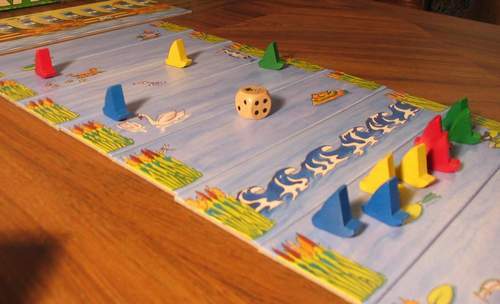游戏设计流程(Game Design Workshop)
2011秋季学期修了南加大电影学院交互媒體系(陳星漢畢業於這個系)的《游戏设计流程》。可以说,这是我从小到大所上的课程中,比較众不同有意思的一門(作为一名18年的工科学生)。我之前曾經纳闷为什么游戏设计要开在电影学院之下,不应该是程序员编程学的么?后来才发现自己之前对“遊戲”與“設計”的理解不到位。
首先是,设计游戏,和计算机背景,或者说编程什么的没有必然联系。所谓游戏,是一个玩家和系统、玩家之间交互的一个媒介。广义的讲,从身体对抗的橄榄球、足球,到斗智的围棋、国际象棋,靠演技和心理的德州扑克和杀人游戏, 从靠运气的大富翁、飞行棋、石头剪子布,到靠策略的星际争霸、三国志,靠技术的开赛车、格斗,都是游戏范畴。
好的游戏往往具备好的故事背景、形式系统和动态元素。比如,仙剑奇侠传的故事是玩家如此感动,三国的群雄四起的背景也受大家喜爱。形式系统指的是规则和步骤,游戏的玩法,怎么造兵,科技树,完成A需要B。动态元素就是,一些游戏中动态发生的,带来对局势不确定性的元素,玩家可以有多种选择,多种组合技能等。
举个例子,对于抽象游戏诸如,俄罗斯方块这种,故事背景没有什么(有人说他可以和方块对话,这种人悟道了剧情吧)。形式系统就是有多少种类型的方块,怎么样消掉一行,多行同时消掉不同行的额外分数。动态元素就是你不知道后面会出来什么,有的俄罗斯方块还会随机扰乱局面。
说到桌游呢,引入动态元素最常见的就是到色子。谈到色子,必涉及概率。一枚六个面的色子的概率是均匀分布,两枚线性,三枚四枚多枚就不同的分布曲线。有的游戏身只需要8面14面20面的色子,游戏设计者需要把握好随机的概率。太随机完全是运气,太死又缺乏游戏性,玩家都不爱玩。
课程回顾
Up the River -> Mountain Doom
实验作业,2对1的游戏,这种类型的游戏平衡性真的是非常把握。
如果再多加一个玩家,很多机制会突然失效,游戏没有趣味性,玩家没有游戏的欲望。
Series of Tubes
- week1 一个美国同学的主意,就是玩家要在网络成名,贴照片啊,图片音乐的,成为红人。但是机制没有想清楚,做出来和大富翁一样。一种货币,获得到或失去,事件卡片过于随机,无策略可言。我一开始没有搞明白他们的故事,但是作为一个游戏设计,第一个礼拜真的很差劲。三个美国人对于一个疯狂的故事兴致勃勃,我有异议也不好插嘴。
- week2 由于第一个礼拜的失误,我作为一名高年级同学,提出了改良方案。引入第二种货币——名望,以增强策略性。但是我们在实施的过程,并没有取得好的收效。游戏复杂了,有了策略,玩家要选择保持现金流还是立马花出去。保持现金流可以用来购买高等级的物品,同时现金可能被事件影响而失去,立马花出去可以带来收益,但是低收益。所谓,高危险,高收益,这是游戏制衡的一个经典原理。但是还是过于随机,并且拍卖环节不尽人意,高的价钱没有带来高的利益,玩家自然不愿意冒险。还有一个原因就是,玩家不知道所谓利益大概是什么样的。
说到拍卖,我一直想有一个这样的游戏,玩家的游戏在于游戏之外的物理和社交性,而非游戏里面的机制设计。这也是游戏的未来趋势之一。这种游戏也可以一直玩下去,和不同的人玩有不同的乐趣。
- week3 第二次游戏测试也变得乏味:没有人愿意购买道具,游戏成了掷色子的游戏。大家似乎失去了信心。要重新搞一个游戏,我个人是反对的认为应该在设计上下功夫,但是他们三人还是已经厌倦了。结果,最后成了一个另一个僵尸游戏。概念就是,用不同的类型的片拼贴走格子。虽然用到了3vs1的概念,但是这样的游戏特别难平衡,我们在试验游戏中就感受到了。后来测试中,发现非常多的漏洞,玩家可以轻易的使游戏进入无聊的境地,游戏无法进行下去。玩家的行动方式也是我不赞成的。
由于时间紧迫只好草草收场,交了作业。
RPG
这种口述RPG的方式对我来说非常新颖,因为毕竟是亚洲人,没有接触过DD系列之前。
上课和老师同学一起,我host了一下,感觉还是对系统理解不深刻。同时英文表述不够好。
在ISI花一个下午把剧本写出来,这个剧情之前我就酝酿了很久。
我会在另一片文章具体讲我构造的故事。
為什麼奪寶奇兵,古墓麗影,龍門客站(飛甲)
Rich Man‘s Bluff
我们想了一个很好的故事背景。同时我的拍卖和吹牛bluff机制也被引入。测试的时候非常有意思,大家都乐在其中,我们感觉要做出一个伟大的设计了。可是实验室玩的时候出了一些问题,初始的卡牌很重要,玩家对于牌的未知使其充满了疑问。另外系列的引入导致玩家都各找所需,拍卖和出售的环节没有达到众玩家参与的目的。
事后我们带来了厨子的主意, 大家都非常喜欢做食物毒死人的观念。
后来做的满成功啊,需要整理和保存文档。
Super smash bros- brawls
How to prepare for presentation
How to pitch
Gaming industry
How to work with people
Culture difference
-------------------------------------------------
Up the river notes

Up the River is racing game with enough simple mechanics to keep it interesting. Suspense abounds as the boats sail against the current. The first player to the dock is not necessarily the winner which keeps the race exciting to the end.
The board is a river sliced into 10 tiles leading up to a harbor. The harbor has 12 numbered docks. The game includes a special die with arrows on one side.
Each player has three sailboats. Players roll the dice and move one of their boats the correct number of spaces.
The mechanics that keep this game from being a straight forward race include: the wave, the sand bar, the wind, the current and the waterfall.
The Wave(high tide) and Sand Bar:
The river has two special tiles: the wave and the sandbar. When boats land on the wave tile, they are pushed three spaces closer to the harbor. When boats come to the sand bar, they “run aground” and must end their turn on that tile.
The Wind:
When a player rolls an arrow, it’s a gust of wind. The wind can blow boats forward or backwards. The player must move one sailboat next to another sailboat of the same color. This can be one of the player’s own boats, to move it up the river or it can be another player’s boat to move it back down the river. The boat must stop at the first boat of the same color.
The Current:
After each player has had a turn, the first player takes the bottom river tile and moves it up to the top, next to the harbor. This nicely simulates the river’s current pushing the boats one tile away from the harbor.
The Waterfall:
Any boats that are on the bottom tile when it’s moved up next to harbor are said to have gone over the waterfall and are out of the game.
The first boat to reach the harbor docks on the number 12 dock and gets 12 points. The next boat gets 11 points, and so on until all the boats still in the game have reached the harbor. Players total their points when the last boat has docked. Highest number of points wins.
This game plays very quickly and is very suspenseful. Initially, it seems very simple to sail all of your boats up the river, but the game is more than just a roll and move. Decisions need to be made in several areas. These include: which boat to move, whether to use the wind to save one of your boats or to hold another player back. It takes some planning to be sure your boats aren’t going to be pushed over the waterfall by the impeding sand bar. Often, it’s necessary to sacrifice a boat over the waterfall.
Overall, I find this a light, fast, fun game. It is a nice family game that kids and adults can enjoy together. Kids find losing their boats over the waterfall pretty frustrating. However, after several plays, my kids learned that they can still win even when they lose a boat and they learned that sometimes it's in their best interest to sacrifice a boat to get a better position on the dock.
Up the River does rely heavily on luck of the dice. However, strategy and planning play enough of an important part to keep it from being completely mindless.
--------------------------------------------
Rule Vs procedure?
formal element
dramatic element
dynamic element
dominant strategy: sacrifice one boat
Reason:
In order to save all of the 3 boats, averagely every boat has to wait for 2 rounds, which means two tiles down the river. That means you have to dice at least 3 every time in order to save them, that is about 2/3 chance each round. but say (2/3)^10, gets a very small value.


